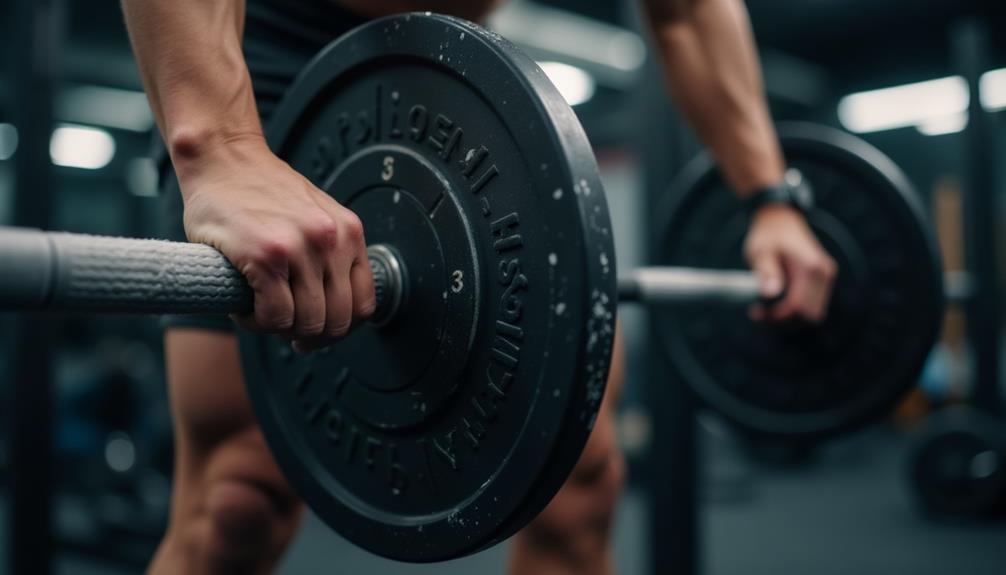Volume-based resistance training works by focusing on the total amount of work you perform, which includes sets, repetitions, and the weight used. This combination plays an important role in stimulating muscle growth and building strength. By tracking your exercise volume over time, you can guarantee progressive overload, which is essential for improvement. As you complete more sets and reps, your muscles repair and adapt, leading to increased size and endurance. This method balances load and repetitions to suit your specific fitness goals. If you're curious about effective programming tips, there's plenty more to discover.
Core Insights
- Volume-based resistance training emphasizes total work through a strategic combination of sets, reps, and weights to enhance muscle growth and strength.
- It focuses on total repetitions and sets to achieve specific training goals, balancing load, reps, and sets effectively.
- High training volume promotes muscle hypertrophy, endurance, and mental toughness, leading to improved overall fitness and workout consistency.
- Muscle growth mechanisms include repair processes, hormonal responses, and satellite cell activation, contributing to thicker and stronger muscle fibers.
- Volume training differs from intensity training, prioritizing total work done over the amount of weight lifted for targeted fitness outcomes.
Understanding Volume-Based Training

In volume-based training, you focus on the total amount of work you perform during your workouts, combining sets, repetitions, and weight. This method emphasizes the overall workload, which can lead to muscle growth and strength gains over time. You'll track your progress by calculating the volume of each exercise. For instance, if you lift 100 pounds for 10 repetitions across 3 sets, your volume equals 3,000 pounds. This approach can be effectively implemented using resistance tubes, which offer a wide range of resistance levels for progressive overload. The versatility of resistance tubes allows for various exercises targeting different muscle groups, making them ideal for volume-based training.
Understanding how to manipulate volume is essential. By adjusting your sets, reps, and load, you can tailor your training to meet specific goals, whether that's building muscle or increasing endurance. Ultimately, the key is consistency and gradually increasing that volume to challenge your muscles effectively.
Key Components of Volume

Understanding the fundamental components of volume is vital for optimizing your training. When you concentrate on volume-based resistance training, consider these three elements:
- Total Repetitions: This pertains to the overall number of reps you perform across all sets. Higher repetitions can contribute to muscle growth.
- Total Sets: The quantity of sets you complete for each exercise matters as well. More sets can enhance overall volume and intensity.
- Load: The amount of weight you lift influences your training volume. Balancing load with reps and sets is essential for effective workouts.
Benefits of High Training Volume

Here's a quick summary of the benefits:
| Benefit | Description | Impact on Performance |
|---|---|---|
| Muscle Hypertrophy | Increased muscle size and strength | Better lifting capacity |
| Endurance | Enhanced ability to sustain activity | Improved overall fitness |
| Mental Toughness | Builds resilience during workouts | Greater workout consistency |
Incorporating high volume into your routine can yield significant fitness advantages, helping you achieve your goals effectively.
Mechanisms of Muscle Growth

Muscle growth, or hypertrophy, occurs through a series of physiological processes triggered by resistance training. When you lift weights, you're causing small tears in your muscle fibers. Your body responds to this stress in several ways:
- Muscle Repair: After your workout, your body repairs these tears, making the fibers thicker and stronger.
- Hormonal Response: Resistance training stimulates the release of hormones like testosterone and growth hormone, which promote muscle growth.
- Satellite Cell Activation: These specialized cells help repair and regenerate muscle tissue, contributing to increased muscle size.
Comparing Volume vs. Intensity

When it comes to resistance training, balancing volume and intensity plays a pivotal role in achieving your fitness goals. Understanding the differences between these two concepts can help you tailor your workouts effectively.
| Aspect | Volume | Intensity |
|---|---|---|
| Definition | Total amount of work done | Amount of weight lifted |
| Focus | Repetitions and sets | Heaviness of the load |
| Goal | Endurance and hypertrophy | Strength and power |
| Example | 4 sets of 12 reps | 3 sets of 5 reps at max weight |
Programming Volume for Beginners

Starting a resistance training program can be overwhelming, especially when it comes to figuring out how much volume to include. For beginners, establishing a balance that promotes growth without risking injury is crucial. Here's a straightforward approach to programming volume:
- Start with 2-3 sets: For each exercise, aim for two to three sets. This helps you build a solid foundation without overdoing it.
- Target 8-12 reps: Choose a rep range of eight to twelve. This range is effective for building muscle while maintaining good form.
- Train 2-3 times a week: Consistency is key. Aim for two to three training sessions per week to allow your body to adapt and recover.
Adjusting Volume for Advanced Lifters

Furthermore, pay attention to your recovery. Higher volume can lead to fatigue, so make sure you're allowing sufficient rest between sessions. Medicine balls can be an excellent tool for functional training and adding variety to your volume-based workouts. Their versatility allows for a wide range of exercises that can complement your resistance training regimen. Lastly, monitor your progress. If you notice plateaus, it may be time to adjust your volume again. By fine-tuning your training, you can optimize your results and keep making gains.
Common Mistakes to Avoid

Many lifters unknowingly make common mistakes that can hinder their progress in volume-based resistance training. Here are a few key pitfalls to watch out for:
- Neglecting Recovery: Focusing solely on volume without allowing for adequate rest can lead to overtraining. Make certain you're giving your muscles time to recover.
- Ignoring Form: Prioritizing the amount of weight lifted over proper technique can result in injuries. Always maintain good form to maximize efficiency.
- Inconsistent Programming: Randomly changing your routine without a structured plan can stall progress. Stick to a well-designed program to guarantee you're progressively overloading your muscles.
Tracking Progress Effectively

Effectively tracking your progress in volume-based resistance training is essential for achieving your fitness goals. To do this, maintain a workout journal or use an app where you can log your exercises, sets, reps, and weights. This allows you to identify patterns and adjust your training as needed.
Here's a simple table to help you visualize your tracking:
| Date | Exercise | Sets/Reps |
|---|---|---|
| 2023-10-01 | Squats | 4×8 |
| 2023-10-03 | Bench Press | 4×6 |
| 2023-10-05 | Deadlifts | 4×5 |
| 2023-10-07 | Overhead Press | 4×10 |
Review your entries regularly to see improvements and stay motivated. Small adjustments lead to significant gains over time.
Frequently Asked Questions
Can Volume-Based Training Be Used for Weight Loss Goals?
Yes, you can use volume-based training for weight loss goals. By increasing workout intensity and volume, you'll boost calorie burn and metabolic rate, helping you shed pounds while building strength and endurance simultaneously.
How Does Nutrition Impact Volume-Based Resistance Training Results?
Imagine fueling your body like a high-performance engine; without proper nutrition, your volume-based resistance training efforts stall. Nutrients repair muscles, boost energy, and optimize results, ensuring you reap maximum benefits from every rep you complete.
Is Volume-Based Training Suitable for All Fitness Levels?
Yes, volume-based training's suitable for all fitness levels. You can adjust the weights and repetitions to match your abilities. It helps you build strength and endurance progressively, making it effective for beginners and advanced athletes alike.
What Equipment Is Best for Volume-Based Training Workouts?
For volume-based training, you'll want dumbbells, barbells, resistance bands, or kettlebells. Each piece helps you target muscles effectively, build strength, and increase endurance. Choosing the right equipment can maximize your workout results and keep things engaging.
How Often Should I Change My Volume Training Routine?
You should change your volume training routine every 4 to 8 weeks. This keeps your workouts fresh, prevents plateaus, and promotes continued progress. Listen to your body and adjust based on how you feel.

